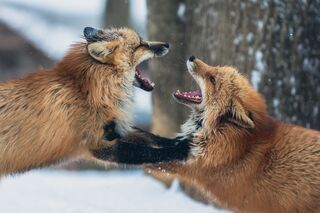Cognition
Diversity vs. Free Expression: Using Scientific Thinking
How can scientific thinking help bridge the gap?
Posted January 29, 2021

Recently, I had the opportunity to present my work on the science of diversity to the MacArthur Foundation. John Palfrey, the President of the MacArthur Foundation, explores diversity issues in his book titled Safe Spaces, Brave Spaces: Diversity and Free Expression in Education.
The title of Palfrey’s book points to one of the most contentious issues on college campuses and in society as a whole in the United States today, which is: How can diversity and free expression coexist on campuses without condoning hate speech or microaggressions?
Demands to disinvite controversial speakers, to include trigger warnings in classes, to provide content warnings on syllabi, and to create safe spaces for marginalized individuals have become contentious topics for discussion on college campuses. What began as a discussion of campus policy quickly spread to the opinion pages of newspapers, social media sites, and cable news stations.
Some critics maintain that safe spaces on campuses are overprotective, infantilizing, and result in the counterproductive coddling of students who feel fragile. According to this view, instead of allowing students to face and learn from new diverse ideas, they are instead protected from exploring real-world issues.
Proponents maintain that safe spaces are valuable for the comfort and assurances they provide students, which helps them cope with the stresses and distractions that might inhibit learning. According to this view, the outright dismissal of safe spaces can amount to harmful disregard for students’ emotional well-being.
Few reviewers have questioned the assumption that a choice has to be made between the diversity of ideas and free expression. But in his book Safe Spaces, Brave Spaces, John Palfrey contends that the essential democratic values of diversity and free expression can, and should, coexist on campus. To accomplish this, he proposes an inventive way to support both the diversity of ideas and free expression: creating separate safe spaces and brave spaces.
In safe spaces, according to Palfrey, students can explore ideas and express themselves without feeling marginalized. In brave spaces such as classrooms, lecture halls, and public forums, students can search for new ideas and knowledge, even if certain discussions may make some students uncomfortable.
However, this leaves the unanswered questions: What kind of educational climate exists in these safe and brave spaces? Do students actually feel comfortable exploring ideas, and expressing themselves and discussing news ideas to further their knowledge in these spaces?
Survey data from the Gallup Knight Foundation Survey (2018, p. 2) suggests that students’ desire to engage in discussions is actually stifled by fear. Although 73 percent of students report that they believe schools should not restrict offensive ideas and political viewpoints, 61 percent of students also believe that the climate on campus prevents them from expressing their views because others might take offense.
Many students on college campuses are walking on eggshells wondering what to say and how to say it, or worse, some students don’t feel safe to share their viewpoint out of fear of reprisal. This reflects the discomfort many have with the current widespread cancel and debate culture. “It no longer feels safe to have conversations with people who have a different viewpoint,” they say.
When the threat of being “wrong and canceled” becomes a daily preoccupation, honest conversations do not happen, and learning cannot be achieved.
This is because the educational climate in many of these spaces is based on debate discourse, and the climate of debate discourse is argumentative. Such discourse often turns into the heated expression of polarized opinions, which results in a tense, stressful climate where students are doing more arguing and defending or avoiding expressing their opinions than actually conversing.
Debating skills may be vital to aspiring leaders, policymaking, and legal engagements in a democratic society. Excelling in debate may be good for professional, educational, and political opportunities for demonstrating verbal and logical aptitude. However, debate discourse supports a partisan, closed style of argument and therefore may not be the best educational climate. Specifically, debate discourse runs the risk of fostering polarization and the tense, stressful climate that we see so often in today’s classrooms and public and political dialogues. So, while debate can be good for some conditions, it may not be good for problem-solving discourse on campus.
This leads us to ask the question: How might we create an educational climate that allows for differing opinions while being conducive to tolerance of viewpoints? The short answer is through facilitated conversations using scientific reasoning. My experience over the past 20 years shows that we can teach scientific reasoning skills that are portable, actionable, and transformative. Scientific reasoning has the ability to transform one-dimensional polarizing views into mutual understanding and open dialogue.
Debate and scientific reasoning are different approaches to problem-solving. What makes scientific reasoning discourse different from debate discourse is that it is self-corrective based on data, evidence, and information.
During scientific reasoning discourse, students are posed with hypotheses rather than opinions that need to be defended as the “right” ones. Personal views and opinions are just the starting points of a working hypothesis. The outcome of scientific reasoning discourse might be the refutation of a relevant view or a synthesis. It might also be an integration of the opposing views or a qualitative improvement of the hypothesis. Whatever the outcome might be, the participants will walk away having explored one another’s viewpoints and gained a deeper understanding of the issue at hand. In scientific reasoning, there is no agenda because the discourse is led by collective and inclusive problem-solving.
The differences between debate discourse and scientific reasoning discourse may be summarized as follows:
Debate Discourse is characterized by the following attributes:
- argumentative
- certain
- persuasive
- making claims
- proving a theory/belief/view
- having one view to prove
- cherry-picking information
- final
Whereas Scientific Discourse is characterized by the following attributes:
- inquisitive
- hypothetical
- considering
- suggesting
- disproving null hypothesis
- all views having equal value
- considering all the evidence
- provisional
In today’s polarized society, conversations on so many topics in the classroom often end up being debates, arguments, and politicized. By contrast, scientific discourse is designed to facilitate conversations on contentious topics between divergent viewpoints in order to foster learning. It bridges the gap between the diversity of ideas and free expression because scientific reasoning discourse follows where the data lead rather than where our opinions take us; therefore, it brings us closer to uncovering a shared truth.
Copyright Mona Sue Weissmark 2021 *Please do not copy or distribute this article without permission.
Thanks to Jennie X. Liang, Jeanette Lieb, and Brian Chin for their assistance.
References
Weissmark, M. (2020). The Science of Diversity. Oxford University Press, USA. See Amazon or Oxford Academic.
Weissmark, M. (2020). Do Diversity Training Programs Work? Creating a Culture of Inclusion through Scientific Reasoning. Skeptic Magazine.
Weissmark, M. (2020). Advice to Students: Learn to Think Scientifically. The Harvard Gazette.
Weissmark, M. (2004). Justice Matters:Legacies of the Holocaust and World War II. Oxford University Press, USA. Amazon
Weissmark, M. & Giacomo, D. (1998). Doing Psychotherapy Effectively. University of Chicago Press, USA.




